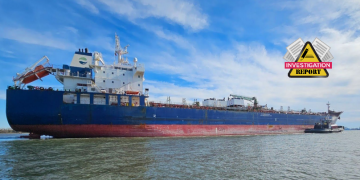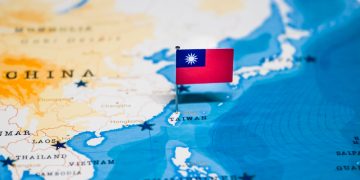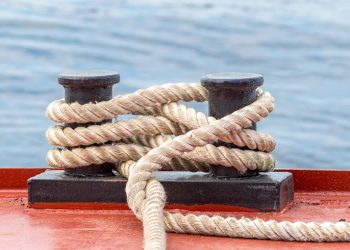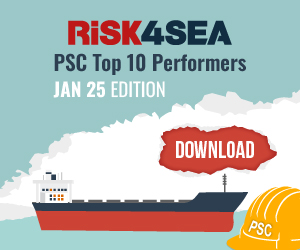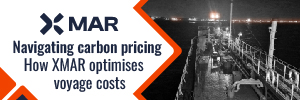Britannia P&I Club informs about best practices and risks related to onboard blending and commingling of liquid bulk cargoes.
According to Britannia P&I Club, it is common for ships to receive requests from cargo interests to blend, commingle, dye, or dope liquid bulk cargoes.
These processes are often carried out to meet specific market requirements, adhere to regulatory standards, or customise the product for end-user needs.
Blending or Commingling?
The terms ‘blending’ and ‘commingling’ are often used interchangeably in the shipping industry when two or more different parcels of liquid bulk cargo are loaded into the same cargo tank.
In contrast, commingling is the intentional admixing (loading on top) of different parcels of cargo, typically of the same grade, from one or multiple loading ports, in the same cargo tank without any segregation.
In summary, blending creates a new product description and specification by mixing different products, while commingling typically involves combining cargoes that already conform to a similar agreed specification. This process does not significantly change the properties of the cargo (e.g., converting an off-spec product to on-spec before delivery to the receivers).
Doping
Doping involves the introduction of additives to either maintain or correct liquid bulk cargoes to meet agreed-upon commercial specifications and quality standards. Doping can enhance fuel properties, such as oxidation stability, ignition quality and knock resistance. It can also improve lubricants by enhancing their frictional behaviour and protective qualities
Dyeing
Dyeing is the process of adding a colorant to oil products to differentiate between various types or grades of fuel for regulatory, tax, or operational reasons without affecting the chemical properties.
Associated risks of on board blending/commingling of liquid bulk cargoes
- Physical blending during sea voyages: SOLAS Chapter VI Regulation VI/5-2 prohibits the physical blending of bulk liquid cargoes and production processes during sea voyages, effective 1 January 2014. However, this does not prohibit doping, dyeing, or cargo recirculation for temperature control and homogenisation. Blending at anchorage depends on the local administration’s interpretation of ‘sea voyage’.
- Final product not meeting specifications: Blending cargo on board, other than physical blending, relies on the loading sequence, with heavier density cargo loaded first, followed by lighter density cargo to facilitate mixing and homogenising during the loading operation. Errors in volumetric loading can result in off-spec cargo when loaded into multiple tanks. Additionally, the ship’s motion at sea can affect the blending process, making it difficult to achieve a homogeneous mixture on shorter voyages. Improper blending due to significant short loading at various sequences can lead to off-spec cargo.
- Chemical reactions: Certain reactions between two components may result in a non-linear escalation of cargoes’ vapour pressure. The ship should ensure PV valves are operating at designed set points.
Inadequate sampling techniques: Final samples taken after loading should be representative and taken at various depths using a zone sampler to reflect the correct status of the blending. Inaccurate sampling leads to unreliable outcomes. - Calculation errors in product quantities: Ensure each tank is loaded with the same volumetric proportion as the entire parcel. Variations in individual tank capacities, ship’s trim, list, and stability requirements should be accounted for during stowage and loading planning, as they can affect the final product blend ratio.
- Bill of lading issues: Cargo may be loaded from different ports, on different dates, or by different suppliers. Blending/commingling can impact the specifications of the cargo, and the carrier could be liable under previously issued bills of lading. The bill of lading should reflect the actual condition of the cargo and indicate any blending/commingling operations.
- Final density/API: The final blended/commingled API/density used for cargo calculation will differ from the original individual API/density of the cargoes. This must be considered during calculations.
Associated risks of on board doping and dyeing of liquid bulk cargoes
- Additives may not be compatible with tank coatings
- The ship’s staff may be requested to carry out doping and dyeing but may not possess the expertise to fulfil the request
- Ship may be requested to carry additives on board for doping or dyeing during the voyage or at the discharge port, which might pose hazards
- Dyeing additives could contaminate the next cargo.
Best practices for on board blending/commingling of liquid bulk cargoes
- Carefully review the charterparty for blending, commingling clauses and seek advice from the Club as needed
- Blending / commingling falls outside the scope of a carrier’s obligations under the Hague-Visby Rules. Seek advice from the Club on obtaining a Letter of Indemnity (LOI) from the shipper or charterer covering any liability, costs, and expenses incurred, including loss of time
- Obtain the loading sequence from the shipper in advance and plan the loading operation accordingly
- If the ship is involved in a shipboard blending operation, wherever possible, request individual cargo component density for each sequence and the expected final density to be used for stowage planning and checks for draft restrictions
- Ensure to obtain written instructions from the charterer for blending/commingling, signed by their representative
- Request written confirmation from charterers/shippers that the buyers (i.e., receivers/consignees) of the cargo are aware of and consent to the proposed blending/commingling
- Whenever possible, load all nominated tanks evenly volumetrically or in the same volumetric proportion as the entire parcel
- Compare shore and ship figures between each sequence to mitigate against alleged losses
- The bill of lading should contain appropriate clauses accurately describing the nature of the operation and dates of loading
- Sampling after the blending of bulk liquid cargoes on board is crucial to ensuring quality and consistency. Sampling should adhere to industry standards and guidelines, using appropriate equipment and procedures.
- This typically involves multi-level sampling. The ship’s staff should witness the sampling process to verify the representative nature of the sample. A sample receipt should be issued and signed by a surveyor for any samples drawn and retained on board.
Best practices for doping and dyeing of liquid bulk cargoes
- Doping or dyeing ashore or during loading is preferable. Doping on board should only be considered in exceptional circumstances
- A doping plan and a comprehensive risk assessment must be prepared
- Check the compatibility of additives with the tank coating with the coating manufacturer
- The ratio of total additives to total cargo also needs to be checked
- Doping or dyeing should be done by an expert appointed by the charterer. The ship’s crew should only carry out these operations in exceptional circumstances and using proper equipment
- Obtain a LOI from the charterers for dyeing or doping
- When dyeing additives are added, care should be taken not to stain the tank top
- Obtain the Safety Data Sheet of additives.








